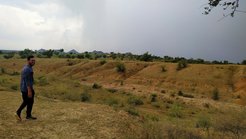Reconstruction of Climate, Vegetation and Fire Across Palaeolithic Transitions in the Indian Subcontinent

The Indian subcontinent occupies a key geographic location as it is at the southern mid-point of Asia. With respect to human evolutionary studies, the subcontinent deserves consideration as a critical area for exploring hominin dispersal processes, particularly the migration of Homo sapiens during the Late Pleistocene. During the Middle and Late Pleistocene, there is emerging archaeological evidence for major technological transitions, changes in cultural adaptations, and varying settlement and subsistence patterns. Unfortunately, the climatic and environmental contexts of these cultural shifts remain poorly understood. In this project, we use a multi-disciplinary multi-site (MDMS) approach to discern how changing global and regional climate impacted hominin-relevant ecosystems across the Indian subcontinent.
The MDMS project will seek to obtain novel information about the environments that hominins were occupying in India, allowing us to examine technological and behavioural changes. A range of multi-proxy palaeoenvironmental analyses will be conducted, including bulk isotopic analysis of soil organic matter (δ13C and δ15N values), compound-specific isotopic analysis (δ13C and δD values) of extracted leaf waxes, and soil carbonate isotopic analysis (δ13C and δ18O values). Palaeofire activities will be investigated using the extraction of macroscopic charcoal particles and Polycyclic Aromatic Hydrocarbons (PAHs) from sediments collected from the archaeological sites preserved in different parts of the Indian subcontinent.
This project also explores the modern plants and sediments across the aridity gradient of the Thar Desert to explore the potential of lipid biomarkers and compound-specific isotopic analysis (δ13C and δD values) in the modern environment to calibrate these proxies for the desert context.












